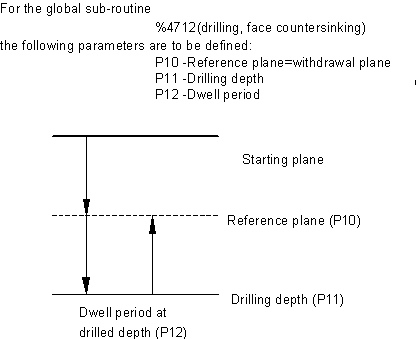Parameters and parameter calculation
In NC-program parameters can be used as place-holder for numerical values. The advantage of parameters is that the value of a parameter may be altered during the program flow. This allows the development of flexible NC-program.
Either the R-word or the P-word is used depending upon configuration for parameter designation [6]-6.44. In the examples described here, P-parameters are used.
Programming example
In a sub-routine, e.g. a drilling cycle, instead of coordinate values (drill depth, drill feed, dwell etc.) parameters are used. The parameters are then allocated with the final values in the respective calling main program :
 Fig.64: Fig. 9.1: Example for application of parameter calculation
Fig.64: Fig. 9.1: Example for application of parameter calculationThe call, in the main program will appear as follows :
:
N100 P10=20.5 P11=12.6 P12=1.2
N110 L4712
: P <expr> Standard parameterP<expr> The parameter index must always be greater than zero, however it can assume any desired value. The maximum number of parameters to be used can be configured [6]-6.19.
In addition to plain parameters, also parameter arrays (e.g. P100[50]) are allowed. The dimension of the arrays can be configured [6]-6.20.
P <expr> [ <expr> ] { [<expr>] } Parameter arraysVia the channel parameters list it can be specified [1]-12, if the P-parameters will be program-globally active.
Parameters can be created (and eventually initialized) in a NC-program either within a declarations block which starts with #VAR and is closed with a #ENDVAR, or implicitly with the first write access. But parameter arrays must always be created inside a declarations block. To the better overview the initialization of a parameter array can be written over several NC blocks by using the \-character. The following syntax is used for creating:
#VAR Start of declaration block
:
: Declaration and initialisation part
:
#ENDVAR End of declaration block
Programming example
#VAR
P10[3][6] = [10,11,12,13,14,15, \
20,21,22,23,24,25, \
30,31,32,33,34,35 ]
P20[3][4] = [40,41,42,43, 50,51,52,53, 60,61,62,63]
P100
#ENDVAR
P200 = 10 P201=11
: Parameters and parameter arrays can also be deleted within the NC-program. For that, the #DELETE command with the following syntax is available:
#DELETE P <expr> {,P<expr>}Programming example
#DELETE P10, P20, P100, P200, P201Furthermore, the SIZEOF and the EXIST function (see chapter 2.6.1.3) are used to determine the dimensions size of parameter arrays and for checking the existence of parameters.